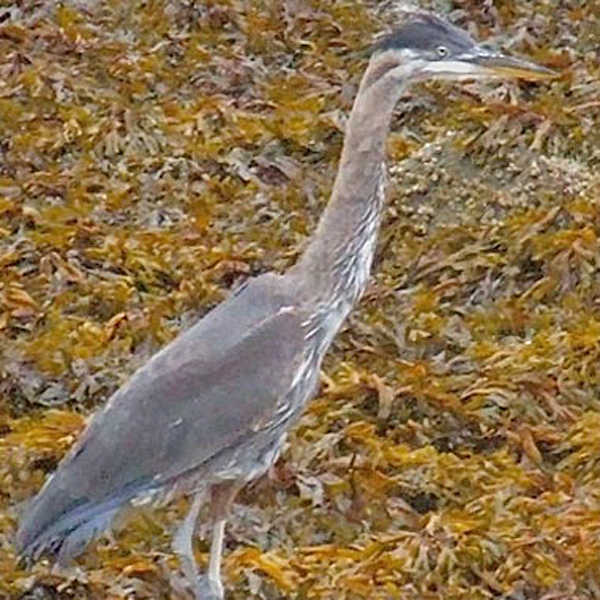NAME: Bleu
TYPE OF BIRD: Great Blue Heron
WHEN RESCUED: Aug. 21.
WHAT HAPPENED: When a Douglas resident discovered a Great Blue Heron hunkered down in her carport, it’s fair to say she was surprised. The bird was hunkered down in a feathery ball. According to a report on the Juneau Raptor Center website, the bird stood upright and spread his great wings, even when cautiously approached. He then made his way around the building and onto the beach where he again huddled. Another heron flew in and landed alongside for a time, but then flew away. After a call to the JRC, a volunteer arrived and attempted to capture the heron, who though unable to fly, was able to avoid his captor on the slippery beach. The next day though, he was successfully caught and transported to the JRC clinic.
INJURIES: Bleu, as he was nicknamed, was initially kept in a large kennel for observation and later examined for injury. On examination, he was found to be thin but no bones were broken and there were no obvious injuries. Nothing explained his inability to fly. He was force-fed small jack salmon but, as is common with stressed herons, he nearly always regurgitated his food. Being a large bird, he needed more space in order to reduce his stress and allow him to begin his recovery.
CARE: Four days after the call, the heron was transferred to another volunteer’s large enclosure that would provide him room to exercise and hopefully regain his strength. Upon release in the mew, he stumbled a bit and unsteadily bumped into a wall. He appeared to have balance issues perhaps from a head injury or an ingested toxin. Since herons usually catch and eat live food, his caretaker provided 11 feeder goldfish in a large tub of water. A few hours later, six had been either tossed aside or eaten and by the end of the day all were gone. The bird was standing and walking but showed no inclination to perch. Small thawed jack salmon were then offered in the water tub, but were ignored so more goldfish were purchased. This time only 3 goldfish were offered along with 4 thawed smelt and the water was set to swirling to encourage Bleu to eat. Very soon all food was eaten. This was repeated twice a day, gradually increasing the number of fish offered until, after several days, the heron was eating smelt and small jack salmon readily and had begun to perch on a log. He continued to make slow but steady progress and began using a higher perch and then flying just a few feet at a time. On Sept. 11, he was moved to a larger enclosure where he could use a number of perches and fly from one to another. Gradually, after some awkward first attempts, he was able to fly from perch to perch, eventually landing gracefully.
RELEASE: On Sept. 21, after a month of care, the heron was transported back to the beach where he was rescued. It was low tide, a favorite time of day for the herons to hunt for food. After being released, he immediately flew far out toward the waters of Gastineau Channel, rested awhile and then flew to the edge of a creek where he alertly watched the water. No doubt he soon caught a meal. The reason for his illness was never determined but, given time, he was able to heal himself.
MORE ABOUT THE GREAT BLUE
HERON: These large herons — with wingspans up to six feet across — patrol the tidal sloughs, saltwater inlets and beaches, as well as a variety of streams, shallow lakes, ponds and marshes, according to the “Birds of Alaska” guide by Bob Armstrong.
• Message phone for the Juneau Raptor Center, 586-8393; emergency pager, 790-5424.
For more information about the JRC, go online to juneauraptorcenter.org.

